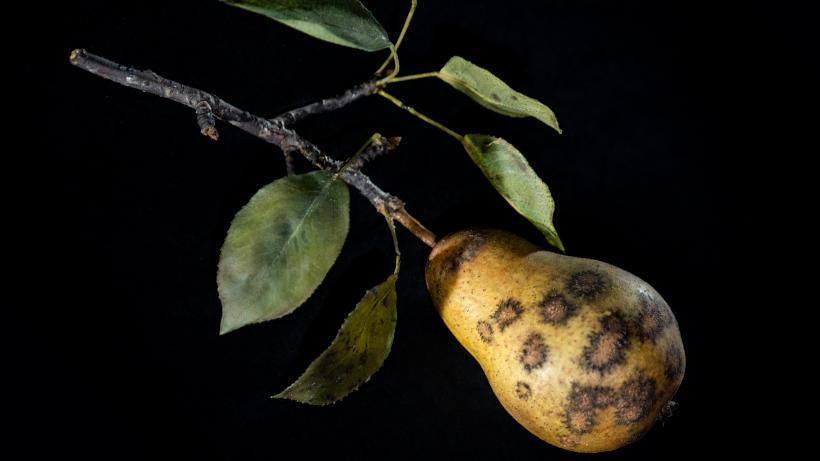Glass Models of Decaying Fruit Set to Go on View After Two Decades in Storage
Designed to serve as teaching tools, the delicate glassware reveals the ravages of such diseases as peach leaf curl, pear scab and gray mold
/https://tf-cmsv2-smithsonianmag-media.s3.amazonaws.com/filer/1d/fa/1dfa42f1-8db1-41e3-a79e-a831292ce787/strawberry_with_penicillium_sp_mold_fragaria_sp_model_791_rudolf_blaschka_1929.jpg)
The 20 or so specimens featured in the Harvard Museum of Natural History’s upcoming Fruits in Decay exhibition suffer from an array of ailments: among others, peach leaf curl, pear scab, gray mold, brown rot, blue mold and fire blight. The macabre collection of apricots, strawberries, plums, peaches and pears mesmerize—but no matter how lifelike they seem, the items on display are no more real than the plastic produce found in a children’s play set. As Jessica Leigh Hester reports for Atlas Obscura, the diseased fruits, which are marked by shriveled leaves, pale fuzz and discolored dark patches, are actually glass models. Crafted by Czech artist Rudolf Blaschka between 1924 and 1932, they were designed to serve as teaching tools.
The fruits are just a small selection of the more than 4,300 models made by Rudolf and his father Leopold for the university’s Ware Collection of Blaschka Glass Models of Plants (known colloquially as the “Glass Flowers”).
Donald Pfister, a mycologist and curator of Harvard’s Farlow Library and Herbarium, calls them “the culmination of [Rudolf’s] lifelong attention to accuracy and innovation,” in a press release. “They illustrate the effects of fungi as agents of disease in plants and point to their importance in agricultural systems.”

The last time the decaying fruits were on view was 2000. For nearly two decades the models have stayed in storage to protect them against light, vibrations generated by visitors’ footsteps and residual surface soot dating to when the museum was heated using coal. “From a conservation perspective, it was a good thing they came off exhibit, so they could rest, if you will,” conservator Scott Fulton tells Atlas Obscura.
The fruits also faced threats stemming from the passage of time. As Fulton explains, the layers of proteinaceous glue and paint that lend the models an aura of authenticity can shrink, delaminate and even pull away from the glass when subjected to dry conditions. At the same time, the lead oxide the Blaschkas used to lower the melting point of the glass came with an unexpected side effect: When humidity skyrockets, Fulton says, the compound “migrates through every capillary and crack it can find,” crystallizing on the models’ surfaces as white splotches.
Back in 2017, Fulton told Harvard Gazette’s Jill Radsken that the spotting “looks like the disease” to the untrained eye, which was, of course, a problem. At the time, the curator was readying for Rotten Apples: Botanical Models of Diversity and Disease, a show focused on just one variety of decaying fruit.
According to a 2011 article written by David Whitehouse of the Corning Museum of Glass, Leopold originally drew on his glass-working skills to create costume jewelry and glass eyes used cosmetically by humans who had lost their own and by taxidermists seeking to make their stuffed specimens more lifelike. Later, the elder Blaschka, aided by his son Rudolf, started making models of marine invertebrates. The verisimilitude of these undersea creatures led George Lincoln Goodale, founder of Harvard’s Botanical Museum, to commission the artists to craft similarly realistic glass plants. (At the time, scientific models were more commonly made from papier-mâché or wax.) Today, the extensive collection represents 780 plant species, thousands of healthy flowers and blooms, and—of course—disfigured fruit.
Fruits in Decay is on view at the Harvard Museum of Natural History from August 31, 2019, to March 1, 2020.
/https://tf-cmsv2-smithsonianmag-media.s3.amazonaws.com/accounts/headshot/mellon.png)
/https://tf-cmsv2-smithsonianmag-media.s3.amazonaws.com/accounts/headshot/mellon.png)